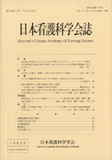Japanese
English
- 販売していません
- Abstract 文献概要
- 参考文献 Reference
要旨
疼痛発現機序ならびにその客観的評価法については多くの報告があるが,今だ十分な解明はなされていない.こうした状況下にもかかわらず,実際の臨床場面にあっては,患者から痛みの訴えを受けた場合,その患者の表現中から,痛みの性質や強さを査定し,適切な看護をせまられることが多い.その手がかりを得る一手段として大学生・成人・高齢者の集団を対象に,精選した痛み表現語彙33語について,0=痛みを感じないから,10=耐えられない痛みまでの11段階法を使用し,過去の痛み体験を基に痛み表現語がもつ痛みの強度値について調査した.その結果,加齢に伴い痛みの強度値は下降する傾向にあり,強度値の高い群と低い群における痛み表現語の配列は,どの集団でもほぼ一致した.つぎに,大学生・成人・高齢者の集団別に痛み表現語各語がもつ強度値をt検定すると(p<0.01),16語に有意な差のない表現語があり,この強度値と表現語の属性を併せ図式化することを試みた.
Abstract
Although we have many reports about the pain threshold mechanism and the method of objective assessment, there are so many factors which are not yet made clear.
Pain is an important warning signal for the maintenance of life and yet is also a sensory experience which the sufferer feels uncomfortable and wants to avoid, if possible.
This symptom of pain can not be co-experienced by a third person and can be confirmed by the latter only via complaints. Language of pain is used for the expression of this pain in terms of its nature and intensity.
However, there are many people who are suffering from pain in the clinics. The author believe that the health professional must identify the pain and must make accurate assessment of pain in regarding the intensity and nature of pain complained by patients. Then, to find a tool for the pain assessment, on college students, adults and old men groups, the author investigated pain intensities on the basis of their painful experiences, using a vocabulary of 33 words selected for the expression of pain. Each word have eleven-point scales from 0=free from pain to 10=unbearable pain. As a result, the pain intensity fell down with aging and all groups practically agreed in the arrangement of words expressing the pain intensity high or low.
Next, t-test of the intensity of each word by groups (p<0.01) revealed 16 words without significant difference. Both these intensities and attributes of these 16 words were schematized.
Copyright © 1991, Japan Academy of Nursing Science. All rights reserved.


